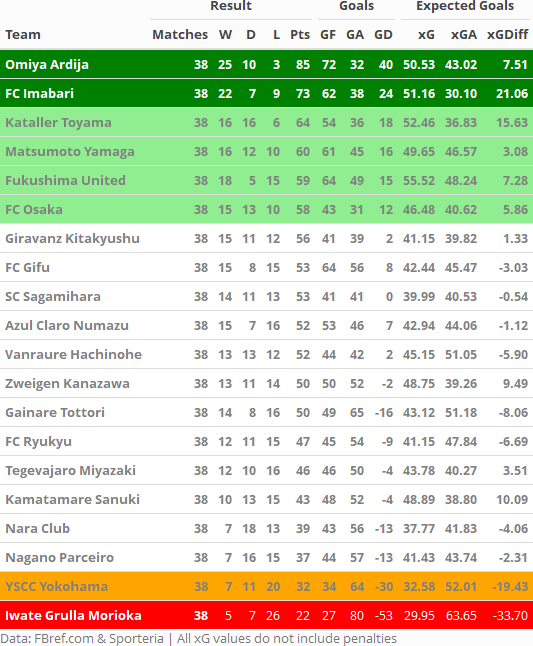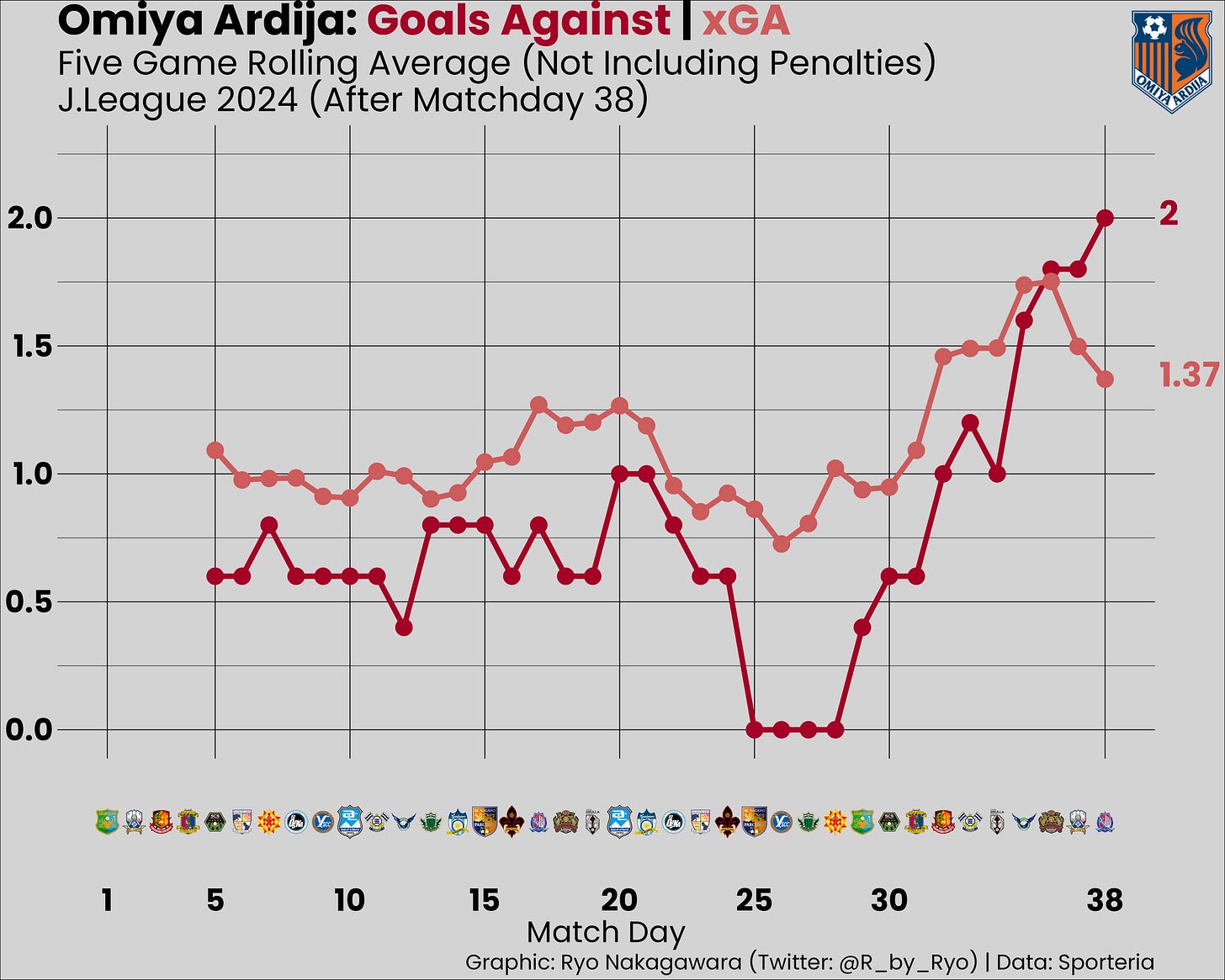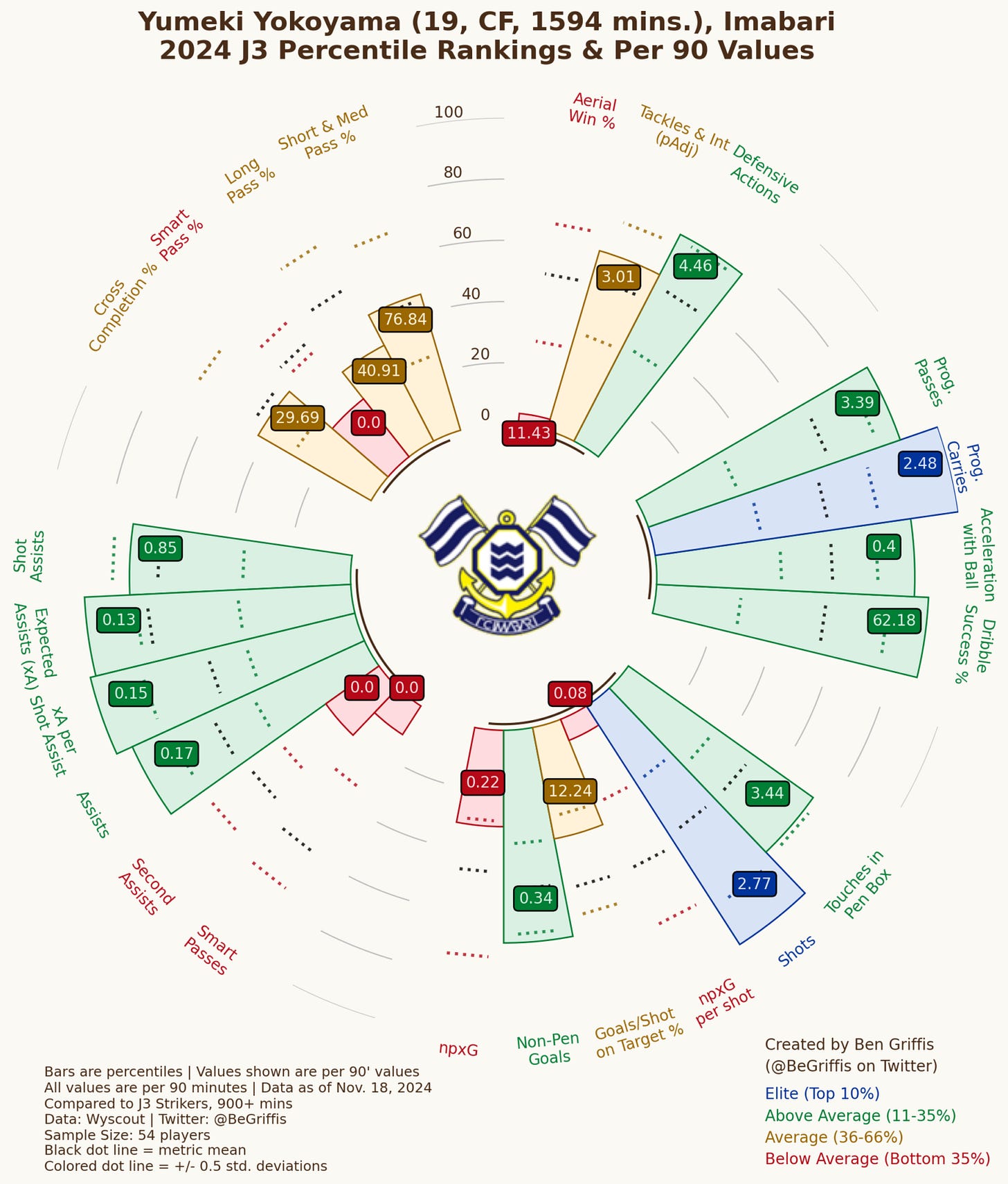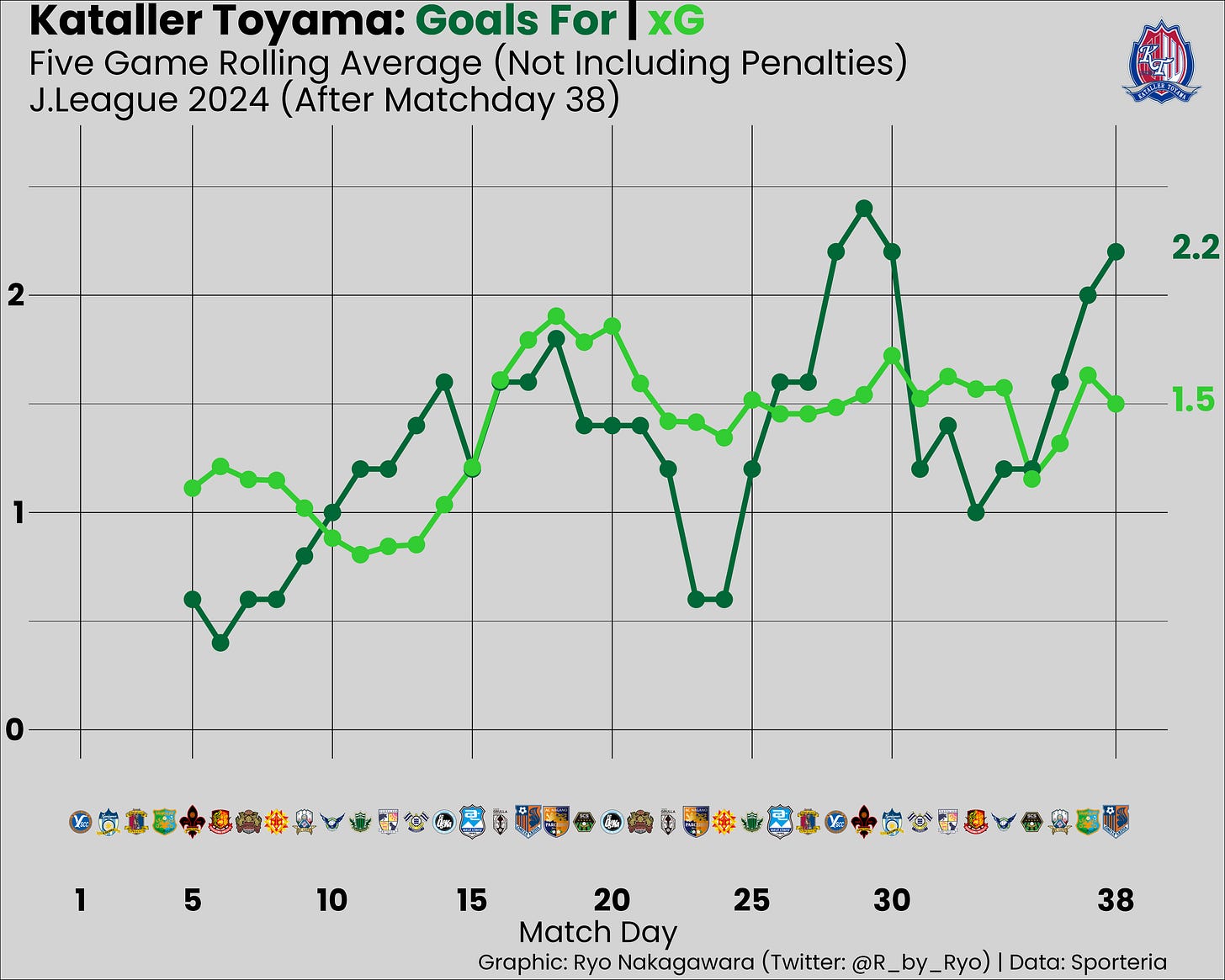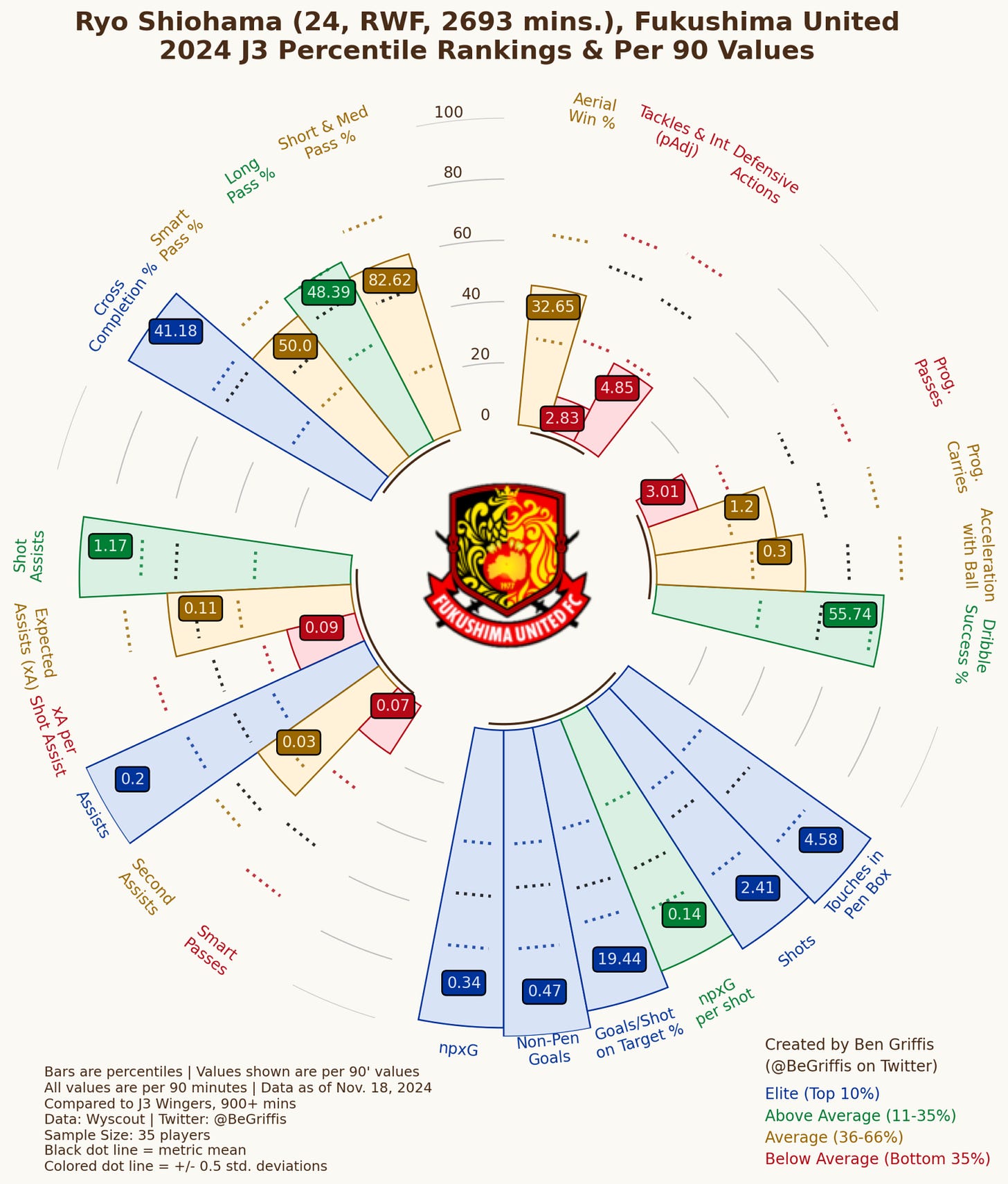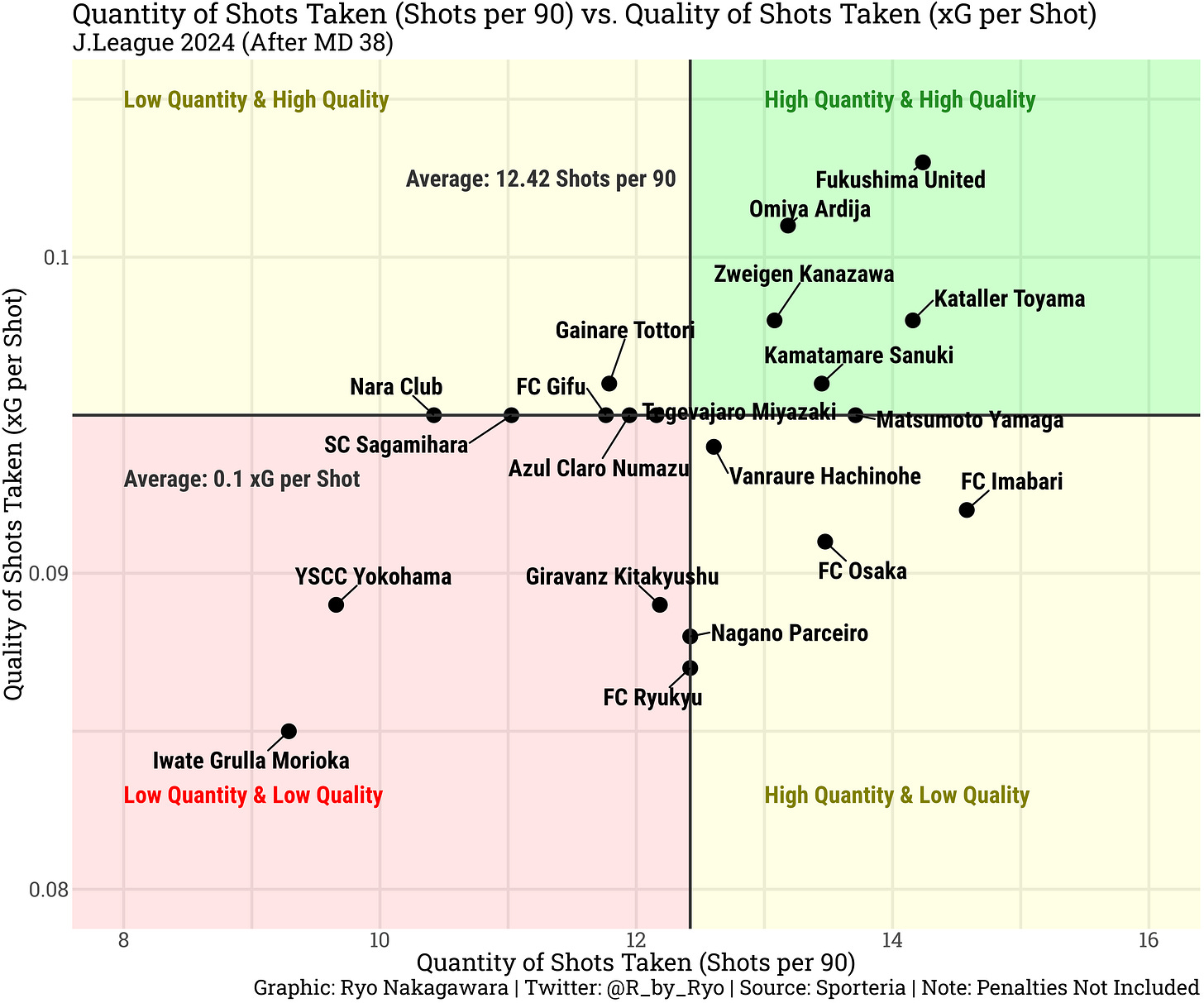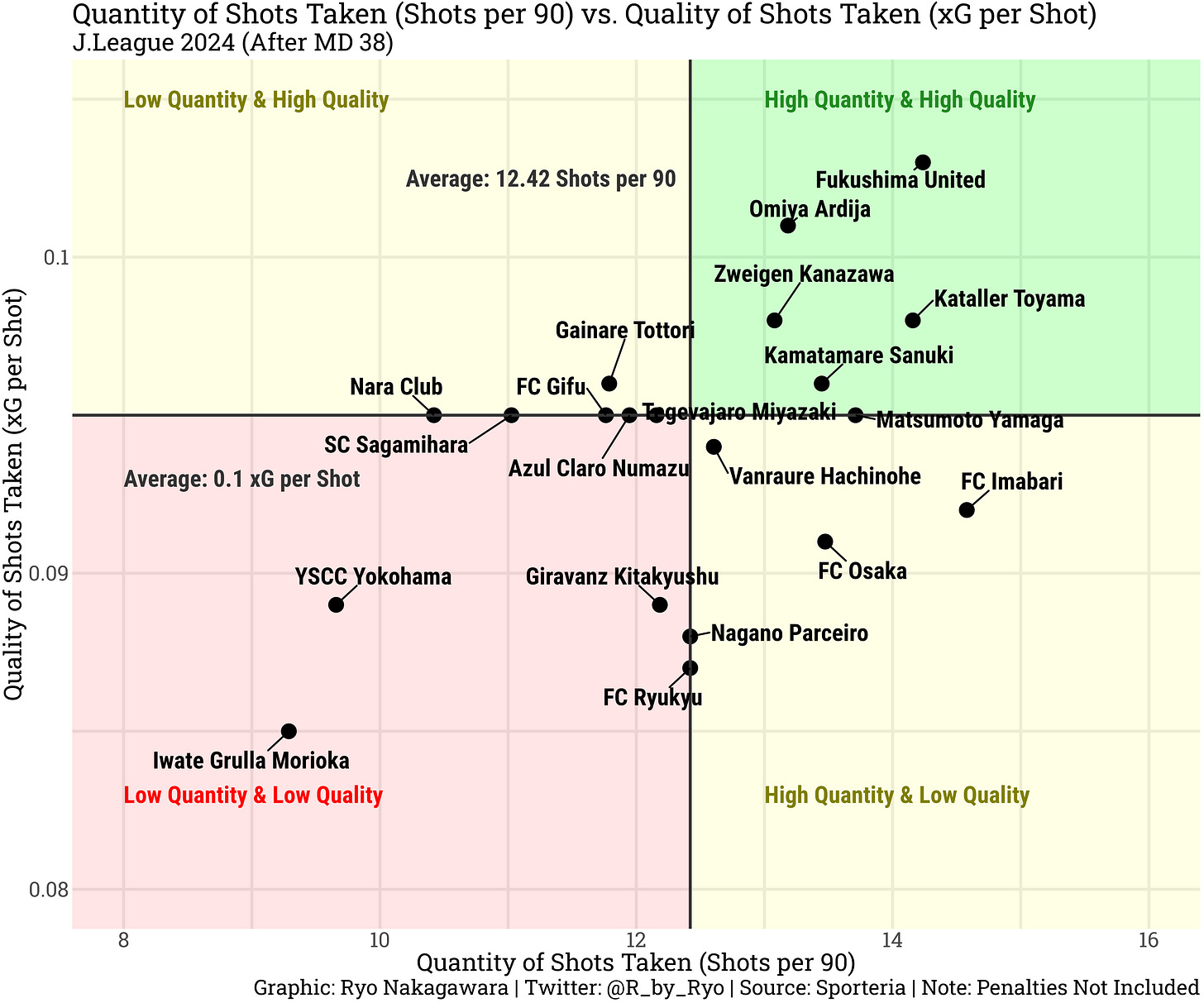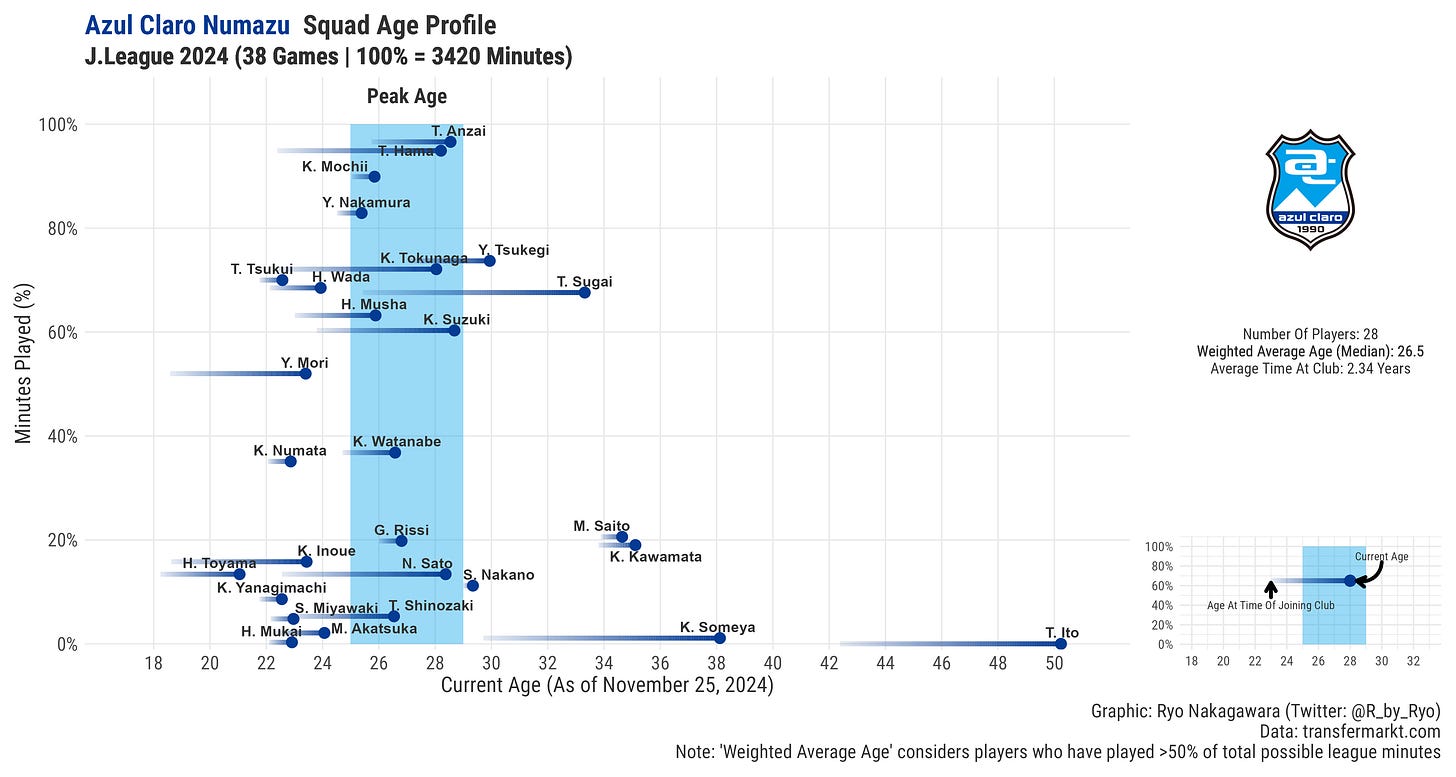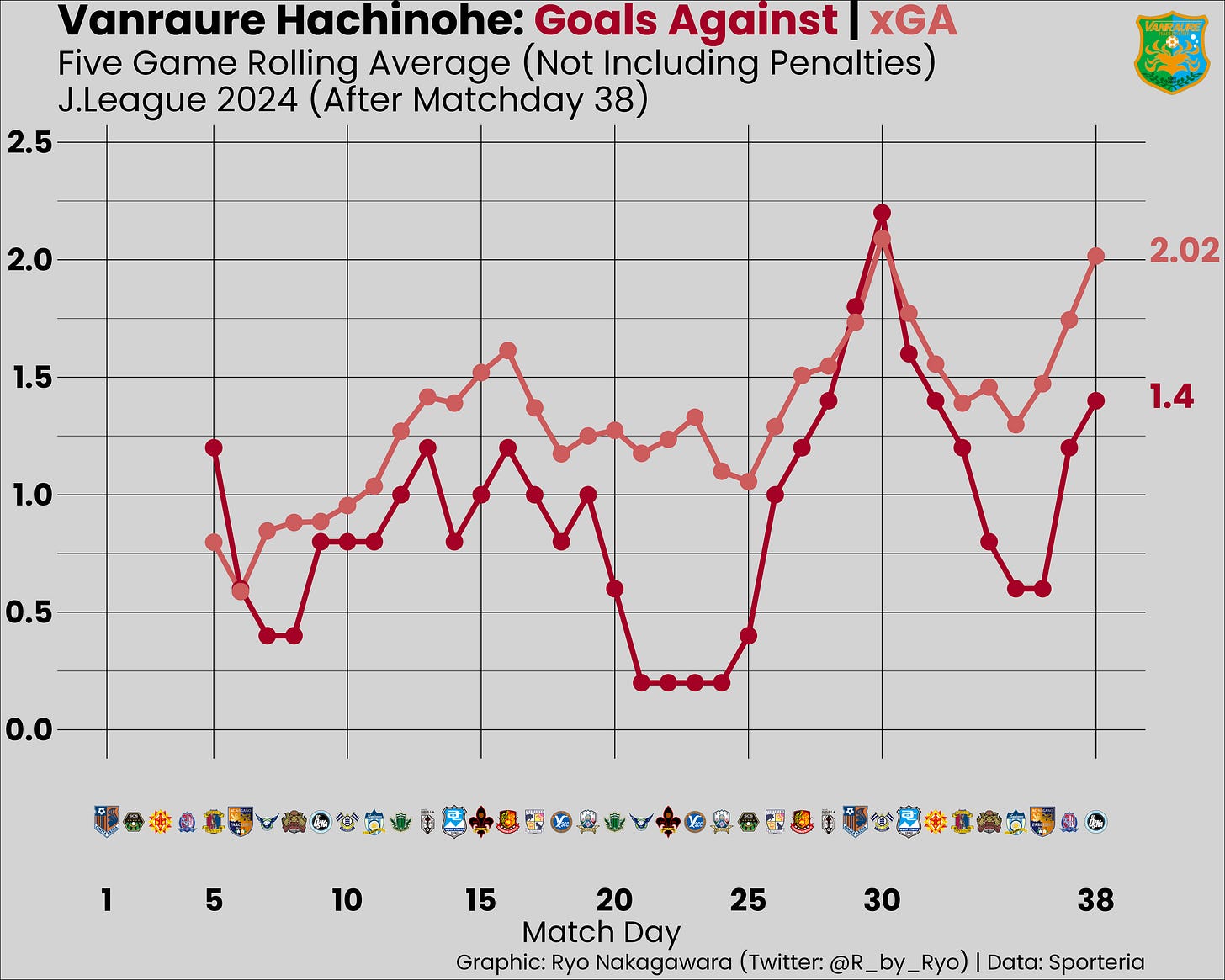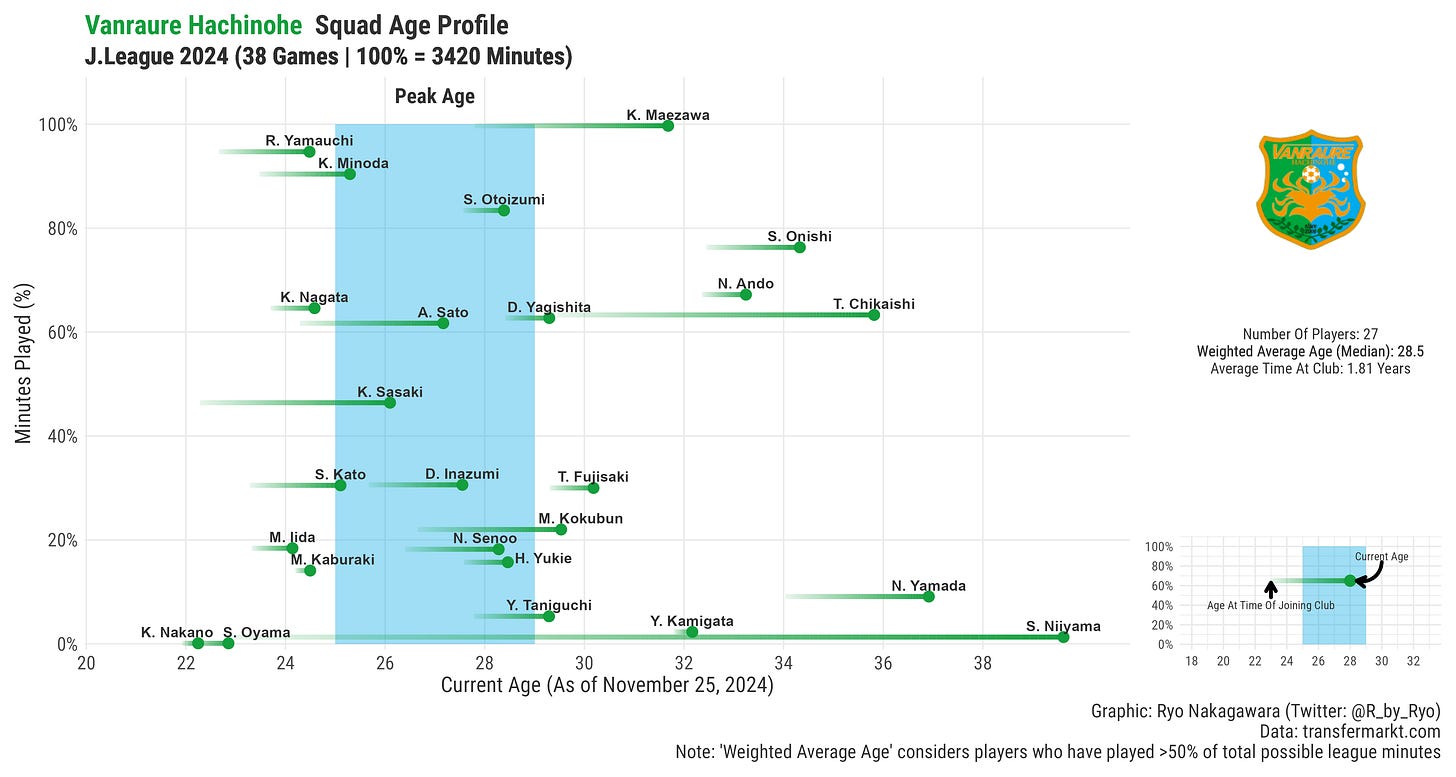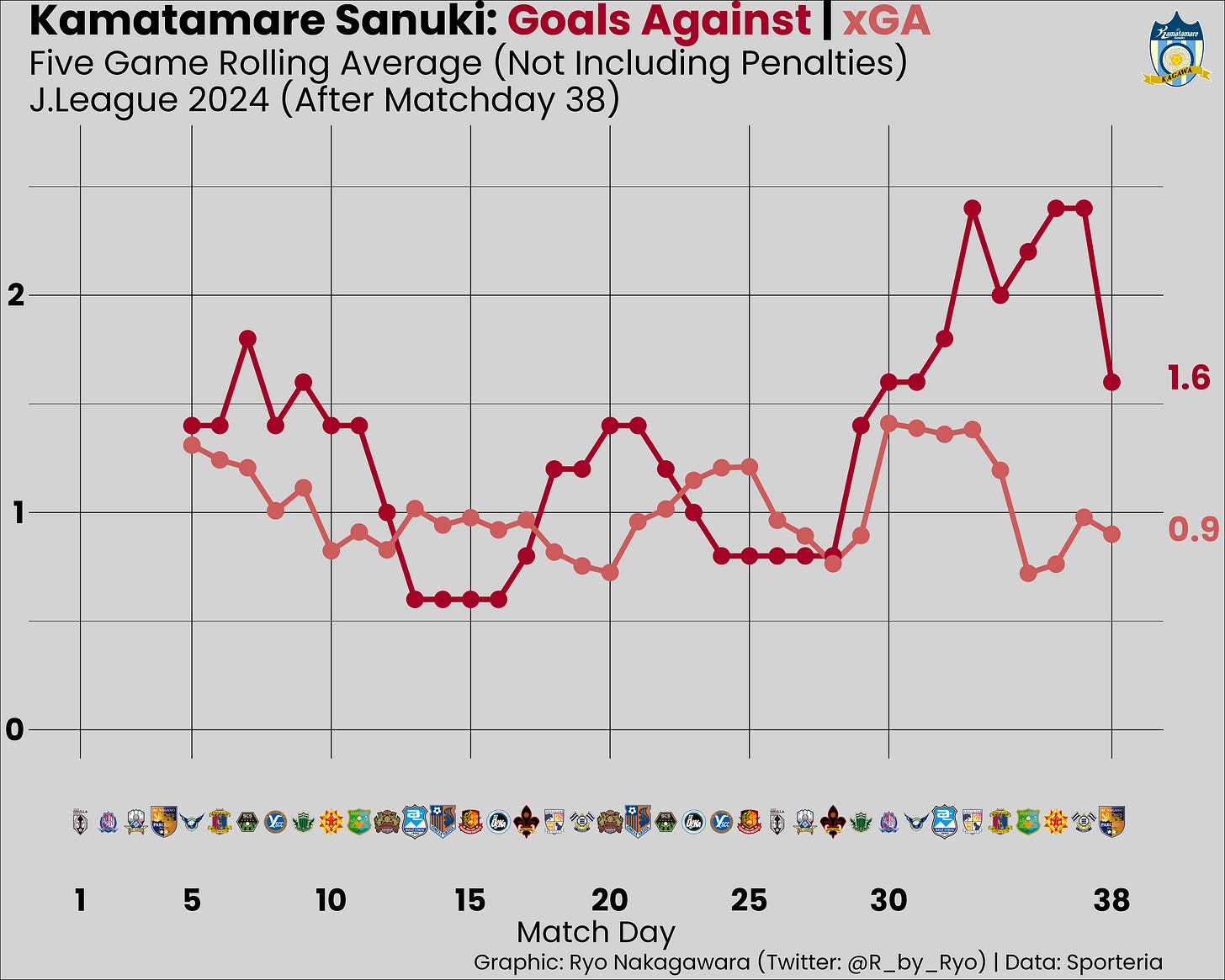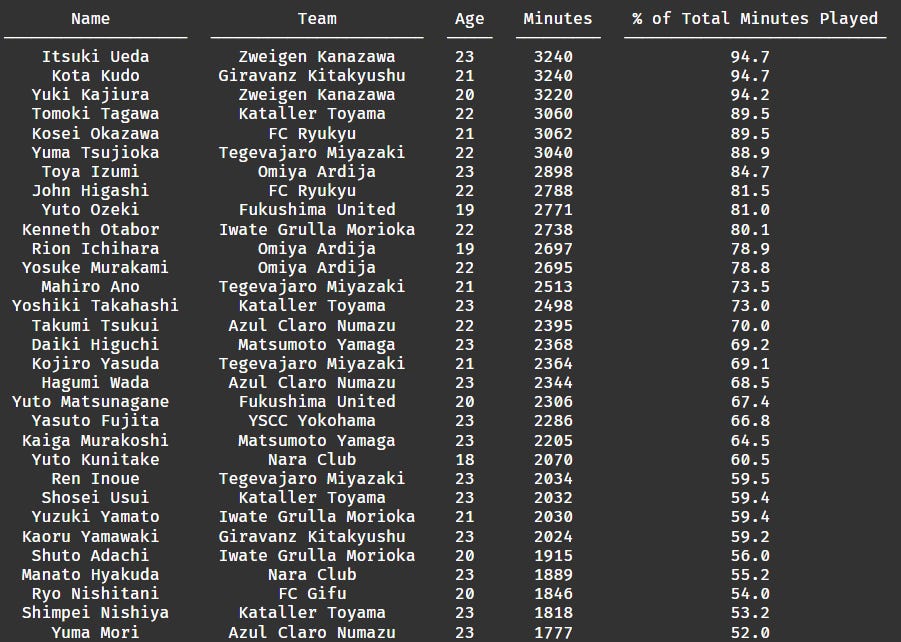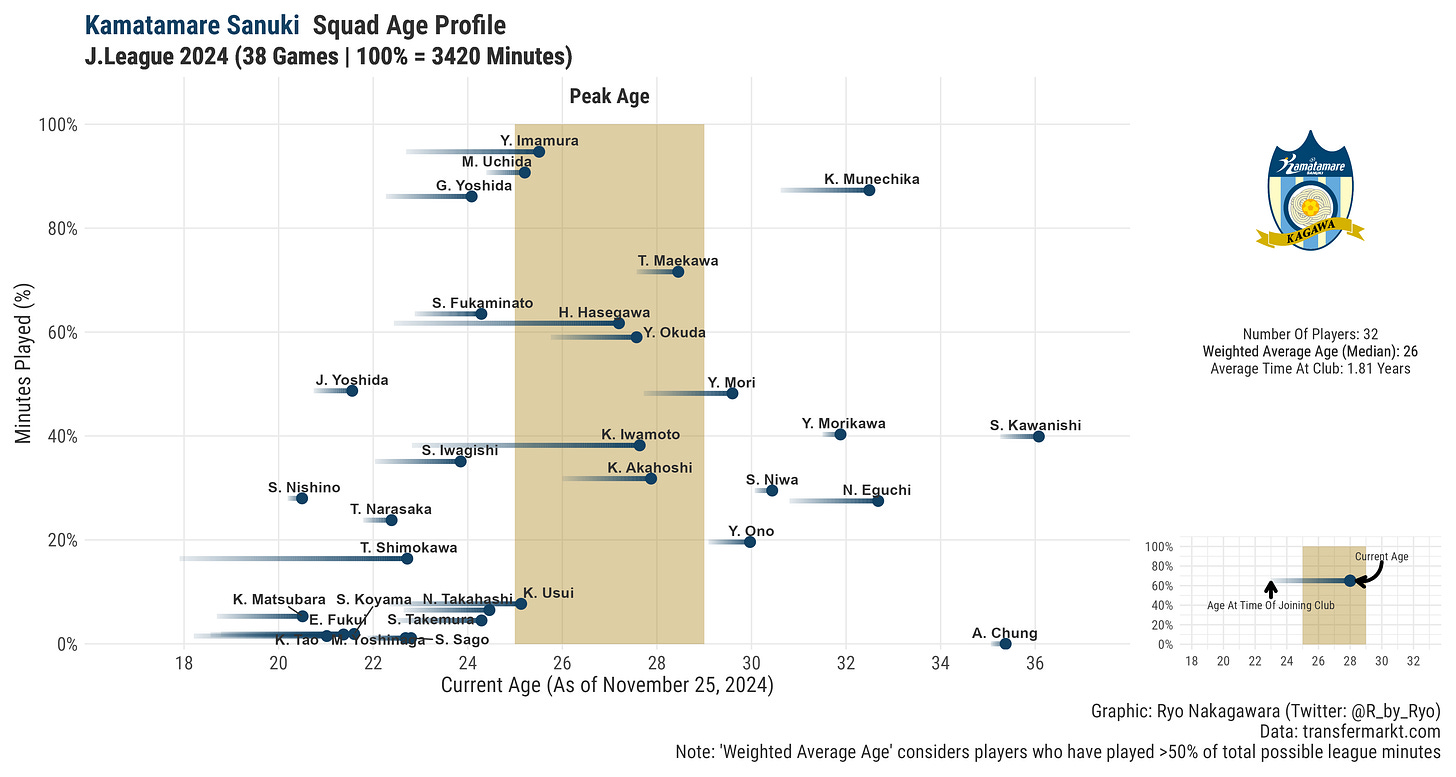J3 2024 Season Review
Omiya Ardija stroll to the title. FC Imabari also promoted. Iwate Grulla Morioka crash out to the JFL.
Hello again, this time is the J3 Season Review! For those unfamiliar, I take a detailed look at each and every team with both data and my eyes.
This review consists of:
The league table
A section on every J3 team: Summary overview, tactics, data, players, etc.
A section on the different types of data viz: Explanations and link to the viz for every team
Some notes, warnings, disclaimers, etc.:
All the data stuff is done with R.
To keep up to date with all of what’s happening in J1, I made a giant Twitter thread of lots of cool informed people to follow on Twitter for English language/international J.League content. You can find it here!
Oh, I’m also on BlueSky now.
All of the shots and xG related stuff you see in the viz are non-penalty stats. Exceptions are stuff like the time interval and scoring situations plots. When I mentioned these stats in writing I usually mean non-penalty at the team level but I explicitly write it out at times just to be super clear. The xG by Japanese data providers always include penalties so I have to go and match shots to penalties and take off 0.8 xG myself (it’s a whole darn process all for a simple “X minus 0.8” operation).
Just in general I am constrained data-wise by what I have (especially in J3!). I wish I had more granular data but that’s not publicly available!
Data sources: Transfermarkt, Sporteria, Football-Lab, FBref
Once again, this has taken up a gargantuan amount of time for me to watch/read/code/compile/organize so please like and share it across all of your social media, your IRL (in-real-life) friends, your family, your dog, etc.
Let’s get started!
League Table
If you’ll recall from the mid-season review, Omiya were handidly in the lead… and they simply kept that lead without too much fuss. The Squirrels Orange-Red Bulls only lost 3 times throughout the entire season and were somewhat on autopilot mode for most of the second half. FC Imabari rocketed up the table to finish 2nd. The play-offs for the final promotion spot are still on-going but it’ll be Kataller Toyama facing off against Matsumoto Yamaga next Saturday!
Down at the other end of the table is Iwate Grulla Morioka who were absolutely woeful all throughout, finishing with a paltry 22 points. YSCC Yokohama are currently locked in a J3/JFL promotion-relegation death match vs. Kochi United and the aggregate score is 1-1 right now.
Omiya Ardija (1st, 85 points)
25 Wins // 10 Draw // 3 Losses
Location // Stadium: Omiya // Nack5 Stadium
Manager: Tetsu Nagasawa
72 Goals (1st); 32 Conceded (2nd)
50.53 xG (4th); 43.02 xGA (10th)
Top goal scorer: Kenyu Sugimoto (10 goals)
Goalkeeper: Takashi Kasahara
Omiya Ardija are your J3 2024 champions! This was achieved with four whole games left to play after a 1-1 draw with 2nd place FC Imabari in October. Like I said in the mid-season review, things were extremely smooth sailing for Omiya as they dominated the league at both ends of the pitch.
Looking at Ardija from a statistical point-of-view is going to be a bit weird considering just how dominant they were from early on in the season. Due to that, for a large chunk of the latter half, Omiya were simply drifting along without too much urgency in my opinion. They certainly let things slip on the defensive side of things in the final few months or so of the season.
The teenage Center Back, Rion Ichihara, earned a lot of plaudits over the past season and a half. He has even captained the side as the Center most defender in a Back 3. Even if his stats don’t necessarily pop-out but a lot of it was just how dominant Omiya Ardija were in front of him. I do talk a bit about the difficulties of interpreting data in these contexts in the piece below.
Shogun Soccer Scouting #3: Rion Ichihara
A hearty hello to you all! Today I’m (finally) back with another Shogun Soccer Scouting feature… on Rion Ichihara.
Toya Izumi had to drop down all the way to J3 from Vissel Kobe but it gave him a chance to perform as he has been one of the best creators in the league with his incisive passing and he had 6 assists.
Of course, we can’t go without talking about the man, the myth, the legend, Kenyu Sugimoto who looked very good in J3, finishing off with 10 goals and 7 assists which is more than what he’s managed in the past 4 years combined!
Omiya surprised a lot of people with a whole bunch of somewhat high profile reinforcements over the summer to really cement their title chances as well as getting their squad J2-level ready as they brought in the likes of Takuya Wada, Fabian “Lasso” Gonzalez, Oriola Sunday, and Tetsuya Chinen. The arrival of the new forwards meant that Kazushi Fujii’s playing time was rather limited in the 2nd half of the season which was disappointing for me personally as I quite liked him in the early parts of the season.
Of course, the biggest off-the-pitch news was the full sale of the club to the Red Bull organization. In line with the acquisition there are now huge ambitions and expectations for the club. While the target next season is to survive in J2, ultimately their goal is not just J1 promotion but even beyond…
Other data viz:






FC Imabari (2nd, 73 points)
22 Wins // 7 Draws // 9 Losses
Location // Stadium: Imabari // Imabari Satoyama Stadium
Manager: Toshihiro Hattori
62 Goals (4th); 38 Conceded (4th)
51.16 xG (3rd); 30.10 xGA (1st)
Top goal scorer: Marcus Vinicius (Índio) (19 goals)
Goalkeeper: Jon Ander Serantes
FC Imabari had a very good 2nd half of the season as they came up from 5th to secure 2nd and an automatic promotion back up to J2. To put into perspective just how good their 2nd half of the season was:
[1st Half of the Season to 2nd Half of the Season], (+/-Difference)
xG: 22.35 to 28.81 (+6.46); Goals Scored: 22 to 40 (+18)
xGA: 17.16 to 12.94 (-4.22); Goals Conceded: 22 to 16 (-6)
A +10 or so point swing in terms of xG and a big +24 swing in terms of goals! So, Imabari managed to start being far more clinical with their chances as well as lowering the quality of the chances allowed to opponents and not conceding as much at the same time. Imabari continued to tightened up an already good defense and finished with the best xGA in the league.


On the attacking side of things, Marcus Vinicius (Índio) had a stellar season finishing as the joint league top scorer (Gifu’s Fujioka) with 19 goals from 17.49 xG (includes 3 penalties) and 4 assists. Out of the total 19, the Brazilian scored 8 headers which contributed a lot to how good Imabari were at set pieces this season.
Yumeki Yokoyama (younger brother of Birmingham City’s Ayumu) had a breakout season as a teenager with 6 goals and 5 assists. Even with that goal haul, I think if he improves his shot locations he can consistently score more goals (I wish I had access to a shot map…). You can see below that while he takes quite a lot of shots, the quality of them aren’t great as shown by the non-penalty xG per shot and non-penalty xG percentiles. Besides goals, he's clearly extremely creative and drives Imabari forward with his passing and dribbling.
After several seasons of “almosts” where they finished 5th and 4th, Imabari were able to finally achieve not just promotion, but in a direct way by avoiding the play-offs. It’s really nice to see a club with a lovely soccer-specific stadium and local support rewarded with what will be their first ever journey into J2!
Other data viz:





Kataller Toyama (3rd, 64 points)
16 Wins // 16 Draws // 6 Losses
Location // Stadium: Toyama // Toyama Athletic Stadium
Manager: Michiharu Otagiri
54 Goals (6th); 36 Conceded (3rd)
52.46 xG (2nd); 36.83 xGA (2nd)
Top goal scorer: Tsubasa Yoshihira & Shosei Usui (9 goals)
Goalkeeper: Tomoki Tagawa
Kataller Toyama created lots of chances and overall were certainly one of the better teams in this league but they didn't have an outright goal scorer to finish off their chances. Despite having the 2nd highest non-penalty xG of 52.46, Toyama “only” scored 54 goals (6th most in the league). A fact that exemplifies this problem is that while Toyama have only lost 6 times this season, they drew a whopping 16 games!
Tsubasa Yoshihira and Shosei Usui finished only on 9 goals a piece which seems low given the team's attacking output. Usui looks a promising player, a striker able to get lots of shots off and decent in the air.
Of course, one thing that is without a doubt is that Toyama’s defense was quite solid throughout the season. Shosaku Yasumitsu impressed from Left Back while on-loan 22-year old goalkeeper Tomoki Tagawa guarded the goal quite well.
Kataller Toyama are currently up for a promotion decider against Matsumoto Yamaga. After consecutive seasons up among the best teams in J3, will 2024 be finally the time Toyama return to J2 for the first time since 2014?
Other data viz:






Matsumoto Yamaga (4th, 60 points)
16 Wins // 12 Draws // 10 Losses
Location // Stadium: Matsumoto // Sunpro Alwin Stadium
Manager: Masahiro Shimoda
61 Goals (5th); 45 Conceded (8th)
49.65 xG (5th); 46.57 xGA (14th)
Top goal scorer: Hayato Asakawa (13 goals)
Goalkeeper: Issei Ouchi
As recently as matchday 33, Matsumoto Yamaga were in mid-table but a five game winning streak at the tail end of the season confirmed their place in the promotion play-offs. This also speaks to just how tight the J3 table was this season!
Yusuke Kikui had another excellent season, completely matching his tally from 2023 with 6 goals and 10 assists once again. I would think he will get picked up by a J2 team if Yamaga don’t make it up to the play-offs this time around as it’s very clear that he can climb further up the J.League ladder.
Matsumoto Yamaga were in J1 as recently as 2019 but they dropped all the way to J3 in 2022. They have had to rebuild and despite getting close, they have continued to disappoint despite their large fan base and financial backing (relative to the rest of the league). Perhaps the 2024 play-offs will be a change in their fortunes? As of this review’s release, Matsumoto have won their semi-final vs. Fukushima United and are going to be facing off vs. Kataller Toyama on Saturday!
Other data viz:







Fukushima United (5th, 59 points)
18 Wins // 5 Draws // 15 Losses
Location // Stadium: Fukushima // Toho Stadium
Manager: Shuhei Terada
64 Goals (2nd); 49 Conceded (10th)
55.52 xG (1st); 48.24 xGA (16th)
Top goal scorer: Ryo Shiohama (16 goals)
Goalkeeper: Kenshin Yoshimaru
In his first ever season as a professional manager Shuhei Terada has put together a very exciting attacking outfit with lots of flowing possession sequences and dribbling flair from the wings. They finished the season tied for the 2nd most goals, 64 from an xG of 55.52. So sure, a decent amount of good finishing played a part but given how many shots and the good quality of those shots on average that Fukushima were able to consistently create, I think it’s fair to say they were the best attacking team in the league.
It’s very interesting to watch how brave their Center Backs and midfielders are in trying to thread the needle to players between-the-lines to progress and break down the opponent block. A big part of this effort is Yuto Ozeki, who excels as either the recipient of these type of passes or as the one playing them into other teammates. I wrote a report on him a few months ago in excruciating detail.
Shogun Soccer Scouting #5: Yuto Ozeki
Hello, welcome to another Shogun Soccer Scouting feature, this time on Yuto Ozeki.
Further forward, Ryo Shiohama and Kota Mori have excelled as the wingers driving into the box with their dribbling skills. 24 year old Shiohama in particular has rightfully earned a lot of plaudits with 16 goals (from 10.38 xG) and 7 assists. It wouldn’t surprise me if a J2 team came calling even if Fukushima were to get promoted.
Indeed, Fukushima United are actually quite unique in just how many goals they’ve scored off the dribble. They have 12 while the median across the league is 4!
A player that I think will go under the radar due to how bright the aforementioned players are shining is Kanta Joujo who, when I was observing Ozeki over the summer, made some pretty good cameos from the bench. In fact, Joujo earned himself a starting spot in the last few months of the season! I feel like if Yuto Ozeki’s loan to Fukushima isn’t extended by Kawasaki Frontale next season, Joujo might be able to pick up some of the slack in terms of ball progression.
Fukushima United were frustrated in quite a few games in that despite their attacking prowess, they did find it hard to break down teams without a great striker in the box to complement their goal-scoring wingers. On the defensive side of things, from watching their games I feel they had issues dealing with quick counterattacks and crosses were a major pain point as well.
Regardless of what happens in the play-offs, this was a successful season for Fukushima United and Shuhei Terada is a manager I want to keep an eye on in the near future.
Other data viz:






FC Osaka (6th, 58 points)
15 Wins // 13 Draws // 10 Losses
Location // Stadium: Machida // Hanazono Rugby Stadium
Manager: Naoto Otake
43 Goals (15th); 31 Conceded (1st)
46.48 xG (8th); 40.62 xGA (8th)
Top goal scorer: Daigo Furukawa (7 goals)
Goalkeeper: Tatsunari Nagai
Despite losing Ryo Shigaki to Renofa Yamaguchi in the off-season, FC Osaka continued to be one of the better defensive teams in the league under Naoto Otake’s guidance. Although one does need to make a caveat that although they conceded the least goals in the league, it came from the 8th best xGA. Perhaps they could’ve been closer to an automatic promotion spot if they didn’t suffer a seven game win-less streak in the middle of the summer (matchday 20~26).
Things stayed much the same in attack with a heavy reliance on set-pieces (37.2% of goals) and second balls (11.6%) as Shunsuke Tachino was a consistent set-piece threat (3 goals and 3 assists).
In open-play, Rikuto Kubo was the main threat from the Right Wing with his dribbling and crossing. All-in-all for a team that was in the JFL just two seasons ago, this has been a rapid rise for FC Osaka. Regardless of what happens in the play-offs, this is a successful season for them.
Other data viz:







Giravanz Kitakyushu (7th, 56 points)
15 Wins // 11 Draws // 12 Losses
Location // Stadium: Kitakyushu // Mikuni World Stadium
Manager: Kohei Masumoto
41 Goals (17th); 39 Conceded (5th)
41.15 xG (16th); 39.82 xGA (5th)
Top goal scorer: Ryo Nagai (14 goals)
Goalkeeper: Yuya Tanaka
Ryo Nagai's 14 goals kept Kitakyushu with some hope of a play-off spot but it just wasn’t enough in the end... Most of their goals came from set-pieces and when you also include penalties (6) into the mix, Giravanz scored over 40% of their entire goal haul from these situations rather than in open-play.
Kitakyushu’s defense was pretty good though. Kota Kudo especially, but the fact that he's been one of their best players going forward with his passes from the back along with the attacking threat of Left Back Takaya Inui tells you where the problems lie in this team.
When you consider where the team were in the past few seasons with them finishing in the bottom have since their relegation from J2 in 2021, including sitting at the very bottom last season… this season was progress but ultimately another missed opportunity for promotion. Time will tell if they can keep Kota Kudo (on loan from Urawa Reds) for another season but they overall do have quite a young squad which bodes well for the future.
Other data viz:






FC Gifu (8th, 53 points)
15 Wins // 8 Draws // 15 Losses
Location // Stadium: Gifu // Nagaragawa Stadium
Manager: Yusaku Ueno // Kenichi Amano (from June)
64 Goals (tied 2nd); 56 Conceded (tied 15th)
42.44 xG (13th); 45.47 xGA (13th)
Top goal scorer: Kosuke Fujioka (19 goals)
Goalkeeper: Shu Mogi
It was a very weird season for FC Gifu. A fantastic start where they only lost twice in the first 10 games of the season. Then a pretty horrible mid-season run killed their promotion hopes, including selling their best player, Yuya Taguchi, to Zweigen Kanazawa. Finally, it was all capped off with a excellent nine game run (6 W, 2 D, 1 L) to finish the season just 5 points off the final play-off spot. This run included 9 goals and 1 assist from veteran Kosuke Fujioka!
Overall, Fujioka’s 19 goals came from 13.3 xG (Source: Football-Lab), which contributed to Gifu’s over-performance in terms of goals scored over xG especially in the final months of the season.
Gifu are, if nothing else, a team that are consistently in mid-table. This season though, I think Gifu fans will rue the fact that they couldn’t eke out a few more wins earlier on in the season… At least Gifu fans can relish the fact that Kanazawa finished below them in the table and that Taguchi ended up only scoring one more goal in the rest of the season?
Other data viz:






SC Sagamihara (9th, 53 points)
14 Wins // 11 Draws // 13 Losses
Location // Stadium: Sagamihara // Gion Stadium
Manager: Kazuyuki Toda // Yuki Stalph (from June)
41 Goals (18th); 41 Conceded (6th)
39.99 xG (17th); 40.53 xGA (7th)
Top goal scorer: Keisuke Ito (5 goals)
Goalkeeper: Motoaki Miura
Yuki Stalph returned to Japan to take the reins at Sagamihara despite Kazuyuki Toda doing a fairly decent job for a year and a half. I was not alone in having a lot of skepticism about the decision… By the end of the season, Sagamihara had one of the worst attacks in the league with the top scorer in the team sitting on just 5 goals. They entered the opposition box the least per game in the entire league and were very down low in the rankings for shots per game, shots on target, goals, and final 3rd entries as well!
The defense is… fine actually but no matter how good Sagamihara’s defense is, if you’re not creating chances or scoring despite your (terrible) xG, your club won’t be pushing up the table at all. Yuki Stalph has a very clear problem to tackle in pre-season next year!
Other data viz:







Azul Claro Numazu (10th, 52 points)
15 Wins // 7 Draws // 16 Losses
Location // Stadium: Numazu // Ashitaka Athletic Stadium
Manager: Gon Nakayama
53 Goals (7th); 46 Conceded (9th)
42.94 xG (12th); 44.06 xGA (12th)
Top goal scorer: Hagumi Wada (11 goals)
Goalkeeper: Kenta Watanabe
Gon Nakayama's Numazu finished in a disappointing 10th place, especially when you consider that in my mid-season review they were sitting in joint 2nd! They are a very possession-focused side (most passes per game and highest average possession rate in J3). However, despite the fact that they can get into the final 3rd and the opponent box quite often (3rd and 5th best in the league), they have a hard time actually getting off shots and this is what has sunk them this season (15th in shots and 12th in shots on target).
While a lot of plaudits will go to Hagumi Wada for his goal scoring exploits, he only scored 3 in the 2nd half of the season. Not to mention, Numazu continued their bad habit of only scoring in the last 10 minutes (plus injury time) of games…
Takumi Hama has been the real fulcrum of this side from Left Back. A great passer and crosser of the ball, he's been highlighted by WyScout and Football-Lab data as a the vital part of Azul Claro's attack driving the team forward.
It’s quite evident that Gon Nakayama has managed to instill a possession-heavy style of play at Numazu but two consecutive mid-table finishes is not great. Is it on the players for not being clinical? Is it on Gon for not figuring out how to create actual chances aligned with their ball dominance? It will be interesting to see what happens during the off-season.
Other data viz:






Vanraure Hachinohe (11th, 52 points)
13 Wins // 13 Draws // 12 Losses
Location // Stadium: Hachinohe // Prifoods Stadium
Manager: Nobuhiro Ishizaki
44 Goals (13th); 42 Conceded (7th)
45.15 xG (9th); 51.05 xGA (17th)
Top goal scorer: Kai Sasaki (10 goals)
Goalkeeper: Shogo Onishi
Continuing on from the mid-season review where I didn’t have too much to say about this team… there’s still not a whole lot to say? Well, one interesting thing to point out is the discrepancy between the actual amount of goals they conceded (7th best in the league) compared to their xGA (3rd worst in the league!). You can see below that there were very distinct periods (the dark red line sinking below the pink line) where they just weren’t conceding despite giving away chances.
Hachinohe continued to play their counter-attacking football especially with Shoma Otoizumi bombing forward on the Right flank and crossing to team top scorer Kai Sasaki’s head (3 of Sasaki’s 10 goals came from headers).
Besides the poor underlying quality of the chances they conceded, Hachinohe were in the middle of the pack for a huge variety of metrics and they finished in 11th, which given their finances in a fairly remote region of Japan that’s still quite good! They will want to actually fix their defense if they want to stay up next season though.
Other data viz:






Zweigen Kanazawa (12th, 50 points)
13 Wins // 11 Draws // 14 Losses
Location // Stadium: Kanazawa // Go Go Curry Stadium
Manager: Akira Ito
50 Goals (8th); 52 Conceded (13th)
48.75 xG (7th); 39.26 xGA (4th)
Top goal scorer: Yuki Kajiura (8 goals)
Goalkeeper: Itsuki Ueda
Zweigen had a very Jekyll-and-Hyde season as they had a horrible start, a resurgence in mid-season where they were well in the play-off fight, then everything came crashing down as the defense imploded and Zweigen only won a measly two games after July!
I say their defense imploded but overall they actually finished 4th best in total xGA for the season… It seems like a lot of opponents were very clinical at the beginning of the season and a short period during the summer which might explain this discrepancy between their goals conceded and their xGA. You can see below how the dark red line (goals against) jumps up above the pink line (xGA) across different time periods.
Yuki Kajiura had a breakout season, the FC Tokyo loanee with 8 goals and 6 assists playing in an attacking role further forward than in previous years.
The only positive thing you could really say that the table was tight and even though they came 12th, they were “only” 8 points away from a play-off spot. However, for a team of Kanazawa’s stature, the money poured in along with the new stadium, no matter how you try to spin it, this simply wasn’t good enough.
Other data viz:






Gainare Tottori (13th, 50 points)
14 Wins // 8 Draws // 16 Losses
Location // Stadium: Tottori // Axis Bird Stadium
Manager: Kentaro Hayashi
49 Goals (9th); 65 Conceded (19th)
43.12 xG (11th); 51.18 xGA (18th)
Top goal scorer: Shunnosuke Matsuki (11 goals)
Goalkeeper: Riki Sakuraba
Gainare Tottori were pretty awful for most of the season but then came alive in the last few months to finish fairly comfortably in mid-table. Most of the games I watched of Tottori was during the spring/summer in preparation for actually visiting Tottori on vacation in June. and they were not good. I was quite worried when they sold their best player in Hiroto Sese to Fujieda MYFC... and yet they managed to turn things around! A lot of the turn-around seems to have been from somewhat fixing their rather porous defense as Tottori’s attack remained fairly mediocre throughout.
Other data viz:







FC Ryukyu (14th, 47 points)
12 Wins / 11 Draws / 15 Losses
Location // Stadium: Okinawa // Tapic Kenso Hiyagon Stadium
Manager: Kim Jong-Song
45 Goals (12th); 54 Conceded (14th)
41.15 xG (16th); 47.84 xGA (15th)
Top goal scorer: Yu Tomidokoro (12 goals)
Goalkeeper: John Higashi
Well add another example in the “don’t expect great things if you sell your best player/top scorer in the middle of the season” adage as Ryukyu sold 10 goal Haruto Shirai to Consadole Sapporo. Ironically, he was barely used by them as they dropped down to J2… 34 year old Yu Tomidokoro did catch up and eventually overtook Shirai’s goal haul though, he was a big set-piece threat and clearly aging like fine wine. 12 goals and 3 assists for the veteran!
Kosei Okazawa continued to be an asset in possession build-up play for FC Ryukyu and considering his performance, he might get loaned to a J2 club next season though as he's still not quite a J1 Cerezo level player.
Ultimately, it’s a very disappointing end to the season for a Ryukyu team that were in-and-around a play-off spot for most of the first half of the season before tanking in the second, including only winning once in the final 12 games of the season… To be honest, you might have seen this coming considering their underlying xG numbers were never exactly great from the start.
Other data viz:







Tegevajaro Miyazaki (15th, 46 points)
12 Wins // 10 Draws // 16 Losses
Location // Stadium: Miyazaki // Unilever Stadium
Manager: Yuji Okuma
46 Goals (11th); 50 Conceded (11th)
43.78 xG (10th); 40.27 xGA (6th)
Top goal scorer: Keigo Hashimoto (12 goals)
Goalkeeper: Kokoro Aoki
Miyazaki managed to climb out of the relegation zone to finish fairly comfortably in the lower mid-table. They were able to win three times more in the second half of the season compared to the first (3 vs. 9) not to mention the fact that they embarked on a 10 match streak without losing and only lost twice in the last 14 games of the season. A lot of this was based off of a good finishing streak though, see how the “Goals” dark green line hovers above the “xG” neon green line in the last 13 games.
Keigo Hashimoto finished the season with 12 goals and 9 assists as his robust aerial presence and smart movement in the box helped Miyazaki a lot.
Ultimately, you can say that Miyazaki had a very Jekyll-and-Hyde season but it’s clear there are still a lot of underlying problems in the team. They’ll need to address issues on both sides of the ball to push higher up in the table next season.
Other data viz:






Kamatamare Sanuki (16th, 40 points)
10 Wins // 13 Draws // 15 Losses
Location // Stadium: Sanuki // Pikara Stadium
Manager: Atsushi Yoneyama
48 Goals (10th); 52 Conceded (13th)
48.89 xG (6th); 38.8 xGA (3rd)
Top goal scorer: Shota Kawanishi (5 goals)
Goalkeeper: Yusuke Imamura
Sanuki kept punching above their financial weight and a five game winning streak from matchday 23 to matchday 28 was ultimately what led them to J3 survival. A huge factor in Sanuki’s survival was their incredible set-piece acumen with 14 goals (nearly 30% of their total) and a further 3 goals coming from direct set-piece situations.
On the other hand, these stats also make clear the fact that they have struggled in open-play and Sanuki also seem to have a difficult time converting their chances. Their top goal scorer was Shota Kawanishi with only 5 goals while there are five other players stuck on 4 goals. This is all in despite of Gentaro Yoshida’s efforts with his mercurial dribbling ability and launching crosses in from Left Wing Back.
One thing I’m perplexed about is Sanuki’s defense, they somehow conceded 52 goals (13th in the league) even though their xGA was only 38.8 (3rd best in the league!). Teams were just able to run hot in front of goal specifically against Sanuki for some reason…
As I said in the mid-season review for Sanuki, their underlying numbers are pretty decent so for those curious (and the means to access better, granular data) it might be interesting to see exactly why the numbers didn’t align with their performances on the pitch.
Other data viz:






Nara Club (17th, 39 points)
7 Wins // 18 Draws // 13 Losses
Location // Stadium: Nara // Rohto Field Nara
Manager: Julián Marín Bazalo // Ichizo Nakata (from September)
43 Goals (16th); 56 Conceded (16th)
37.77 xG (18th); 41.83 xGA (9th)
Top goal scorer: Yuki Okada (13 goals)
Goalkeeper: Marc Vito
A pretty horrible season for Nara Club in just their second ever season in J3. They parted ways with longtime manager Julián Marín Bazalo in the summer as the results just weren’t tenable (with heavy hearts for all he did for the club in the past few years).
A big factor remained their poor set-piece defending with nearly 30% of their goals conceded coming from these situations.
Yota Shimokawa with 7 assists continued to be fantastic on the Left flank and ahead of him was Yuki Okada who finished the season as Nara’s top scorer with 13 goals from 7.29 xG.
At the end of the day, Nara did survive which is great but they’ll need to do a lot in the off-season to keep their fledgling status as a J.League professional club alive in the coming years as the competition is only going to get tougher from here on out.
Other data viz:






Nagano Parceiro (18th, 37 points)
7 Wins // 16 Draws // 15 Losses
Location // Stadium: Nagano // Nagano U Stadium
Manager: Riki Takagi
44 Goals (14th); 57 Conceded (17th)
41.43 xG (14th); 43.74 xGA (11th)
Top goal scorer: Kensei Ukita (13 goals)
Goalkeeper: Kim Min-Ho
Nagano seem to under-perform every season and in 2024 they finished in the lowest position ever since their entry into J3 back in 2014. Nagano got just a measly 13 points in the 2nd half of the season, of which only one game was a win.
Kensei Ukita only scored twice after the midway point but his 13 goals (from 9.08 xG) was just about enough to keep his team above the relegation zone. I talked about Hayate Sugii in the mid-season review and yeah, still overall a very good passer from the back!
They’ve got a nice stadium, decent support, and even a women’s team but Nagano haven’t been able to progress much in J3. Even worse, their regional rivals Matsumoto Yamaga seemingly have gotten out of their slumber and are making genuine attempts to promote upwards again. Nagano are going to need to make a lot of changes in the off-season if they want to overtake their rivals in the near future.
Other data viz:







YSCC Yokohama (19th, 32 points)
7 Wins // 11 Draws // 20 Losses
Location // Stadium: Yokohama // Nippatsu Mitsuzawa Stadium
Manager: Kazuki Kuranuki
34 Goals (19th); 64 Conceded (18th)
32.58 xG (19th); 52.01 xGA (19th)
Top goal scorer: Koji Okumura (8 goals)
Goalkeeper: Michiya Okamoto
Not a whole lot to say about the sports & culture club... They managed to earn even less points (12) than in the first half of the season (20). Their time in fully professional football might just be up and perhaps it makes sense for the club to drop down into the JFL? We’ll see if Kochi United can beat them in the promotion-relegation play-offs.
Despite the effort of Koji Okumura with his 8 goals and 3 assists, the lack of firepower at YSCC was quite evident. The team were 19th out of 20 teams in terms of final 3rd entries and penalty box entries, which all led to 19th in shots, shots on target, and of course goals.
They will be fighting for their lives against Kochi United from the JFL, with the 2nd Leg coming this Saturday with the aggregate scoreline all evenly poised at 1-1.
Other data viz:







Iwate Grulla Morioka (20th, 13 points)
5 Wins // 7 Draws // 26 Losses
Location // Stadium: Morioka // Iwagin Stadium
Manager: Takuya Jinno // Kei Hoshikawa (from August)
27 Goals (20th); 80 Conceded (20th)
29.95 xG (20th); 63.65 xGA (20th)
Top goal scorer: Kenneth Otabor (5 goals)
Goalkeeper: Takuo Okubo
Iwate have been stuck at the bottom of the table since matchday 13 (since May!) and frankly they never looked like they were going to get out the relegation zone with multiple shellackings by opponents (0-9, 0-6, 1-6, etc.). Iwate had the worst attack and the worst defense in the league by quite some distance and it’s very hard to take any positives from this season.
Iwate changed quite a few things like their manager in August but pretty much anybody was going to have a hard time taking the reins in this situation. On top of the manager, owner Yutaka Akita ceded control of the club to former owners NOVA and resigned his position as CEO. Things are looking very dire for Iwate as a club in general and staff will have their work cut out for them on-and-off the pitch.
Other data viz:






Squad Age Profiles
I changed the calculation of a squad's median age up a bit by simply taking into account only players that have played 50% of more of total possible league minutes. This is so when looking at the 'average' age of a team, we're doing a better job of considering players who are regulars in the team. I am not sure how other people might do it but from playing around with the raw data it looks OK, most teams have around 9~12 players that meet this threshold so I do think I'm capturing the right selection of players in any given team.
Anyway, here's the list of the U-23 players in the league with the most minutes played so far this season (filtered for those that have played more than 50% of total possible league minutes). You might want to keep an eye on these guys in the short-to-medium term. One of the simplest ways to judge a player’s quality is minutes played. It doesn’t matter how much talent you have or how much potential if, in the end, you don’t actually see minutes on the pitch to show it off!
Time Interval
Ideally I would use a 15 minute interval so I could get rid of that one weird section straddling both halves (40-50th minute) but this was the easiest data set I could get. What's noticeable from this data set is that the good teams generally know how to close out a game and don’t concede many goals in the last 10~20 minutes.
Scoring Situations
Ideally, I would have data that concerns all shots or xG accumulated from different match situations as that would mean a much larger sample of data to power any insights (as goals are only the end result and may not give us information about a team's actual performance).
Team Shot Quantity & Team Shot Quality
In the previous few sections we got to know a lot about the goals that J.League teams scored. However, in a sport like soccer/football goals are hard to come by, they might not really accurately represent a team’s actual ability or performance (even if ultimately, it's the end result that matters). To take things one step further I was able to gather data from Sporteria on shot quantity to dive a bit more into team performances. I’ve reversed the order of some of the stats in these next few plots so that in all cases the top right is best and bottom left is the worst teams when looking at their respective stats.
So, what exactly is expected goals (xG)? Expected goals is a statistic where a model assigns a probability (between 0 and 1) that a shot taken will result in a goal based on a variety of variables and is used for evaluating the quality of chances and predicting players’ and teams’ future performances. A xG model only looks at the variables up to the point that the player touches the ball for a shot. Post-shot xG models covers the information about where in the frame of the goal the shot went (“post” as in all the information after the player touches the ball for the shot) but I won’t cover that here.
For some quick primers on xG check the links below:
The following two sections use xG data from Football-Lab. I’m not privy to all of what goes into their model but the explanation page on their website (in Japanese) tells us about some of the information they used:
Distance from goal?
Angle from goal line?
Aerial duel?
Body part used?
Number of touches? (one touch, more than two touches, set plays, etc.)
Play situation? (Corner kick, direct/indirect free kick, open play, etc.)
So, the usual variables that you might recognize from other xG models are being considered. Combining shot quantity and shot quality numbers gives you a much better idea about a team’s performance on either side of the ball.




xG Difference
xG Difference is pretty much the same thing as Goal Difference except that we use xG and xGA rather than goals and goals against. This lets us see very quickly which teams generally outperformed their opponents in terms of quality of chances created to quality of chances conceded based on a xG model. This time around I also included the team's results inside the bubble points. So it's easier to see whether a team that had a positive xGD in a specific match couldn't manage to win the game or vice-versa. You ideally want to be below the diagonal line and winning (W) these games as well.
Five Match Rolling Averages
Goals vs. Goals Against
xG vs. xGA
xG vs. Goals
xGA vs. Goals Against
Summary
The J3 2024 season was extremely unpredictable with many teams showing a lot of inconsistency except for Omiya Ardija (in a good way) and Iwate Morioka Grulla (in a bad way). As such it was actually a very tight league table for most of the season as teams would leapfrog multiple places over each other based on the results of a single matchday.
This season saw the return of the J2 promotion play-offs but also the first ever J3/JFL promotion-relegation play-offs too! This past weekend:
Matsumoto Yamaga advanced past Fukushima United
Kataller Toyama advanced past FC Osaka
So we’ll be seeing Matsumoto Yamaga travel to play against Kataller Toyama for a ticket into J2. Meanwhile YSCC Yokohama and Kochi United are in a deadlock with the aggregate score 1-1 as the return leg in Yokohama happens this weekend.
Even without the play-offs, this 2024 J3 season was another great one to remember!
Thanks for reading!




